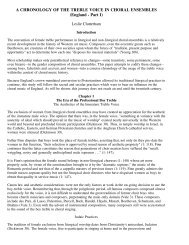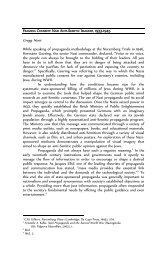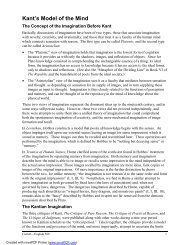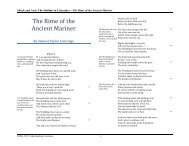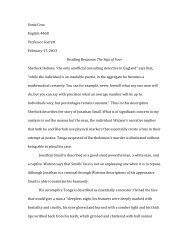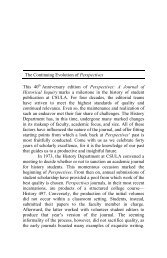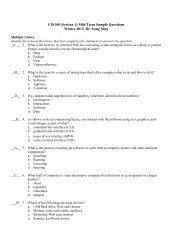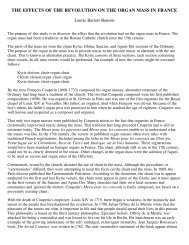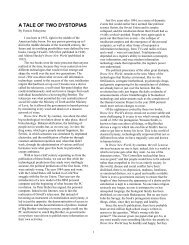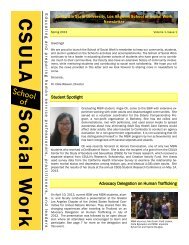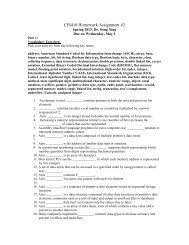The Eme - California State University, Los Angeles
The Eme - California State University, Los Angeles
The Eme - California State University, Los Angeles
Create successful ePaper yourself
Turn your PDF publications into a flip-book with our unique Google optimized e-Paper software.
theaUTZ<br />
...part 3<br />
<strong>The</strong> <strong>Eme</strong><br />
Publication of <strong>The</strong> <strong>Eme</strong>riti Association <strong>California</strong> <strong>State</strong> <strong>University</strong>, <strong>Los</strong> <strong>Angeles</strong><br />
PRESIDENT'S MESSAGE Volume XXI, Number 3 Spring 2000<br />
This will be my final<br />
message as president of your<br />
association. Those of you<br />
who attend our May luncheon<br />
meeting—many I<br />
hope—will have a chance to<br />
elect anew president and put<br />
a new face at the head of this<br />
column. I'm mighty glad we have some outstanding<br />
people who have consented to having<br />
their names placed in nomination for the offices<br />
being vacated at the end of June. That's<br />
what noblesse oblige, literally "nobility obligates,"<br />
is all about. "What has that got to do<br />
with a democratic election?" you ask. Well, to<br />
me, the French dictum refers not just to nobility<br />
in its narrow, sociopolitical sense, but to anyone<br />
possessing the ability to perform socially<br />
useful functions. In life, we're called upon to<br />
assume many roles: student, citizen, soldier,<br />
worker, teacher, administrator, spouse, and<br />
parent. Without the willing participation of the<br />
people with the appropriate talents, the requirements<br />
of a smoothly functioning civil society<br />
would be unmet. Many of you, like me, have<br />
been all of the above at one time or another in<br />
your lives, and it hasn't always been by predilection.<br />
As a teenager in the Depression, I would<br />
rather have been playing touch football with<br />
the neighborhood kids than working long hours<br />
in a market on weekends and sweeping the college<br />
chemistry lab on Mondays in FDR's NYA<br />
program, but I did both because I felt obligated<br />
to do as much as I could to ease my parents'<br />
financial burden. When World War II drew us<br />
See PRESIDENT'S MESSAGE, Page 2<br />
LUNCHEON AND<br />
ANNUAL MEETING<br />
FRIDAY, MAY 12, 2000<br />
11:30 A.M. TO 2:00 P.M.<br />
UNIVERSITY CLUB<br />
COST: $12 PER PERSON<br />
Send check, made payable to <strong>Eme</strong>riti<br />
Association, to Clem Padick, 1849<br />
North Altadena Drive, Altadena,<br />
CA 91001, no later than May 4.<br />
For more information, call Clem<br />
at 626-798-9702.<br />
VP STEVEN GARCIA TO SPEAK<br />
AT MAY 12 SPRING LUNCHEON<br />
Steven N. Garcia, vice president for administration<br />
and finance since 1997, will be the<br />
guest speaker at the Spring Luncheon and Annual<br />
Meeting of the <strong>Eme</strong>riti Association on<br />
Friday, May 12, from 11:30 a.m. to 2:00 p.m. in<br />
the <strong>University</strong> Club.<br />
As vice president for administration and<br />
finance, Garcia has responsibility for executive<br />
direction, guidance, and policy formation<br />
for financial and business management operations.<br />
human resource management, physical<br />
facilities, public safety, and housing services.<br />
He also carries fiduciary responsibility in the<br />
role of treasurer for the boards of the Cal <strong>State</strong><br />
L.A. Foundation and <strong>University</strong> Auxiliary<br />
Services, Inc. He serves as the president's<br />
designee to the <strong>University</strong>-Student Union<br />
Board and exercises fiduciary oversight of the<br />
Cal <strong>State</strong> L.A. Associated Students, Inc. To-<br />
See Page 8 for <strong>Eme</strong>riti Association Nomination Committee Report<br />
<strong>Eme</strong>riti Association Fellowship winners Joyce Santo-Diamond (sociology) and Claudia Kelley (nutritional science),<br />
and Jane Matson endowment recipient Glenda Miao (school psychology) pose with Mrs. William Lloyd, <strong>Eme</strong>riti<br />
Association president Leon Schwartz, former Fellowship Fund chair Carol Smallenburg, and current chair Marie-<br />
Antoinette Zrimc, at fall luncheon. <strong>The</strong> William E. Lloyd Scholarship was awarded, for the first time, to James Mestaz<br />
(Latin American studies). Other recipients were Melanie Roberts (<strong>Eme</strong>riti Fellowship; special education) and Dawn<br />
Mays (Jane Matson Memorial Award; school psychology).<br />
gether with other key executives, administrators,<br />
and committees, Garcia serves as adviser<br />
on fiscal matters in addition to serving as the<br />
<strong>University</strong>'s chief fiscal officer.<br />
See SPRING LUNCHEON, Page 6
<strong>The</strong> <strong>Eme</strong>ritimes<br />
EXECUTIVE COMMITTEE<br />
LEON SCHWARTZ, President<br />
FRIEDA A. STAHL,<br />
Immediate Past President<br />
DONALD 0. DEWEY,<br />
Vice President, Administration<br />
CLEMENT PADICK,<br />
Vice President, Programs<br />
LAIRD ALLISON, Treasurer<br />
HARRY S. HALL, Secretary<br />
ELOISE M. KING, Corresponding Secretary<br />
FLEUR B. YANO, Acting Membership<br />
Secretary<br />
DONALD 0. DEWEY, Historian/Archivist<br />
and Academic Senate Representative<br />
JOSEPH CASANOVA, Fiscal Affairs Chair<br />
and Database Coordinator<br />
MARIE-ANTOINETTE ZRIMC,<br />
Fellowship Fund Chair<br />
DONALD A. MOORE,<br />
CSU Academic Senate Representative<br />
DONALD 0. DEWEY, MARY GORMLY,<br />
LEON SCHWARTZ,<br />
CSU—ERFA Representatives<br />
LAIRD ALLISON<br />
CSULA—RPEA Representative<br />
DONALD BURRILL, JOHN L. HOUK,<br />
JACKIE LOU HOYT, JOAN D. JOHNSON,<br />
LEONARD G. MATHY, C. LAMAR<br />
MAYER, ROBERT MILLER,<br />
KENNETH PHILLIPS CAROL J.<br />
SMALLENBURG, FLEUR B. YANO<br />
Members-at-Large, Executive Committee<br />
<strong>The</strong> <strong>Eme</strong>ritimes<br />
ELLEN R. STEIN, Editor<br />
DENNIS KIMURA, Graphic Designer<br />
FRIEDA A. STAHL (Chair),<br />
MARY GORMLY, CAROL J.<br />
SMALLENBURG, Editorial Board<br />
Address copy to:<br />
Ellen Stein, Editor, <strong>The</strong> <strong>Eme</strong>ritimes<br />
Research and Sponsored Programs<br />
<strong>California</strong> <strong>State</strong> <strong>University</strong>, <strong>Los</strong> <strong>Angeles</strong><br />
5151 <strong>State</strong> <strong>University</strong> Drive<br />
<strong>Los</strong> <strong>Angeles</strong>, CA 90032-8253<br />
Phone: (323) 343-3798<br />
Fax: (323) 343-6430<br />
Email: estein@cslanet.calstatela.edu<br />
For information about the <strong>Eme</strong>riti<br />
Association, please call Matthew Warren<br />
in the President's Office, (323) 343-3030.<br />
President's Message (Continued from Page 1)<br />
in, I would rather have been continuing my<br />
college education, begun two years earlier, than<br />
spending three years of my life in a military<br />
uniform risking life and limb as a target of Uboats,<br />
buzz-bombs, ack-ack, and ME 109s, but<br />
Europe and Asia were being ravaged by genocidal<br />
armies and our own country had been attacked.<br />
Fortunately, there was plenty of noblesse<br />
in our youth and millions of us answered the<br />
call to duty.<br />
Of course, not all the things we feel obligated<br />
to do in our lives are as compelling as<br />
helping a family survive the Depression and a<br />
country win a war. Serving my fellow emeriti<br />
as an officer of our association is certainly not<br />
comparable in terms of the sacrifices involved.<br />
Nevertheless, the principle of noblesse oblige<br />
is just as applicable.<br />
When I attained emeritus status in 1987,<br />
Laird Allison, who has by now invested many<br />
years of service in our association as president<br />
and treasurer, asked me to serve as a member of<br />
the Executive Committee. I put him off for a<br />
few years until, running out of excuses, I could<br />
no longer reconcile my reticence with the rule<br />
of noblesse oblige that I prided myself on espousing.<br />
And so I joined the Executive Committee,<br />
and was asked two years ago to serve as<br />
president. Again I felt obligated to accept, in<br />
spite of the time I knew it would take from my<br />
adventures on the local golf courses. On the<br />
whole, I don't regret that decision. It's been a<br />
chore, but a mostly satisfying one.<br />
Now, as I take Frieda Stahl's place in the<br />
more leisurely position of immediate past president<br />
and hand over the reins of our society to<br />
Provost Margaret Hartman<br />
to Retire September I<br />
Margaret J. Hartman, provost and vice<br />
president for academic affairs, recently announced<br />
her retirement from the <strong>University</strong>,<br />
effective September 1, after 30 years of service<br />
as a faculty member and administrator.<br />
Her application for emeritus status is in process.<br />
In light of the fact that Hartman has not<br />
finalized her plans for the near future, rumors<br />
have been running rampant on campus!<br />
Carlos Gutierrez Receives CSU<br />
Wang Family Excellence Award<br />
Carlos Gutierrez, professor of chemistry and<br />
director of Cal <strong>State</strong> L.A.'s National Institutes of<br />
Health Minority Access to Research Careers and<br />
Minority Biomedical Research Support programs,<br />
is one of four CSU outstanding faculty to receive<br />
2<br />
Campus News<br />
the next "noble Roman," I appeal to the noblesse<br />
of all of you who can volunteer some<br />
service to the association to come forward. If<br />
you can't do that and haven't at least sent in<br />
your dues, pray do. And if, for some bizarre<br />
reason, you can't even do that but still desire to<br />
receive our mailings, I beg you to keep us up to<br />
date on your current address, so that my successor<br />
as president and other officers involved with<br />
communication are spared the time and expense<br />
of sending out second mailings, a seemingly<br />
chronic problem with emeriti, who must be the<br />
most mobile demographic group since the legions<br />
of Genghis Khan.<br />
I'd like to end this message by expressing<br />
my thanks to all the noble ones who have worked<br />
hard to keep our association alive and relevant<br />
over the years. That includes, of course, the<br />
members past and present of our executive committee,<br />
Matt Warren and the clerical staff in<br />
President Rosser' s office, and Ellen Stein, Dennis<br />
Kimura, and the technicians who print this<br />
newsletter. I am happy to say that we are now<br />
renewing the practice of awarding certificates<br />
of appreciation to those who have given long<br />
and valuable service to the association. Come<br />
to the May luncheon meeting and honor this<br />
year's awardees. <strong>The</strong> resumption of this practice<br />
was urged on me by Sid Albert, our founding<br />
father, who, like the Cornucopia of<br />
Achelous, never runs out of what is needed for<br />
growth and vigor, which for our association,<br />
besides dues-paying members, means ideas and<br />
dedication.<br />
this year's $20,000 CSU Wang Family Excellence<br />
Award. Gutierrez's award falls under the<br />
category of natural sciences, mathematics, computer<br />
science, and engineering. <strong>The</strong> awards to four<br />
faculty and one administrator will be presented at<br />
a formal ceremony on Tuesday, May 9, at the<br />
CSU Trustees meeting in Long Beach.<br />
In a nomination letter, Gutierrez was praised<br />
for "devoting his entire academic life to enhancing<br />
the educational success of those students<br />
who, in particular, are underrepresented<br />
in the sciences." " . His sincere interest in<br />
students' welfare and his enthusiastic encouragement<br />
of their participation in the chemical<br />
sciences have inspired many of them to select<br />
these fields as careers." In more than 20 years at<br />
Cal <strong>State</strong> L.A., Gutierrez has mentored more<br />
than 180 students through NIH-funded programs<br />
and participation on other projects funded<br />
by the National Science Foundation.<br />
See CAMPUS NEWS, Page 7
AAUP Chapter, Formed in 1950,<br />
Vital to Academic Freedom<br />
By Ake Sandler<br />
In the spring of 1950, a group within the<br />
then-small faculty of <strong>Los</strong> <strong>Angeles</strong> <strong>State</strong> College<br />
organized a chapter of the American Association<br />
of <strong>University</strong> Professors (AAUP),<br />
dedicated to the precepts of academic freedom<br />
espoused by the national organization.<br />
It had an ominous beginning. AAUP was<br />
treated by the college administration of that era<br />
little better than a "red cell," and as the first<br />
chapter president, I was well aware of our precarious<br />
position. We had few members and no<br />
one yet had tenure, so all of us were vulnerable.<br />
How vulnerable became evident when one<br />
colleague, an anthropologist, was summoned<br />
to see the vice president, Chester Milham.<br />
Milham interrogated him about a letter he had<br />
written to <strong>The</strong> People's World, a radical weekly,<br />
in which he discussed a sensational lynching<br />
that had occurred in the South. Milham asked<br />
him point-blank whether he was a communist.<br />
He refused to answer, citing the First Amendment<br />
(that's all he had told me). Milham, consulting<br />
President Howard MacDonald, then<br />
decided to deny him reappointment for the following<br />
year.<br />
At this juncture, the AAUP chapter entered<br />
the picture. As its president, I requested an appointment<br />
with Milham, who was reputed to be<br />
a "socialist buster" and was feared by the fledgling<br />
faculty. In that category, he manifestly included<br />
activist liberals (like myself and others).<br />
I met with Milham in his office, which was<br />
next to MacDonald's, and on behalf of the<br />
AAUP, I protested the firing of that respected<br />
member of the anthropology department. I said<br />
that we at AAUP felt that "the administration is<br />
infringing on his freedom of expression, as protected<br />
by the First Amendment to the Constitution,"<br />
or words to that effect.<br />
Milham dismissed my argument as irrelevant.<br />
His rejoinder, as I recall, was, "We don't<br />
care what he writes or thinks. That's his business.<br />
Or where he speaks or writes. This is purely<br />
an administrative matter. We're not rehiring<br />
several people next semester. He is not being<br />
singled out. Tell your AAUP members that this<br />
is not a case of academic freedom. Sandler, you<br />
have no case."<br />
And he was right. At that time, they could hire<br />
and fire any professor they chose for "administrative<br />
reasons." Cunningly, Milham had cut the<br />
ground out from under us. But we knew what his<br />
real motive was. He was known as MacDonald's<br />
"hatchetman," and he was proud of that role. Thus,<br />
after defending the faculty member, I was sure<br />
that I was also on Milham's "list."<br />
We had to do something drastic or we would<br />
perish as an organization before we had really<br />
got started. Milham would have loved to see us<br />
disperse, and by acting against one of its members,<br />
he might have deterred others from joining<br />
our "subversive" association.<br />
<strong>The</strong>n I had a strategic flash: to invite President<br />
MacDonald to speak at an AAUP meeting.<br />
That might constitute acknowledgment and recognition,<br />
and new members might join. We figured<br />
that many faculty members would come to<br />
listen to MacDonald, who incidentally was famous<br />
for his faux pas.<br />
It worked—many did come to hear the president.<br />
And we in AAUP were not disappointed,<br />
for his presence and speech achieved exactly<br />
the respect we had hoped for.<br />
I don't remember much of what he said, but<br />
the phrase that still sticks in my mind is his<br />
"pronunciamento" that "academic freedom is<br />
so important that it must be exercised with utmost<br />
care."<br />
I'm sure others in the audience reacted as did<br />
the members of AAUP. President MacDonald<br />
had, in effect, unwittingly given us his blessing.<br />
We were now both acceptable and respectable;<br />
new members could join us and did, and there<br />
was nothing Milham could do about it.<br />
See AAUP CHAPTER, Page 6<br />
<strong>Eme</strong>riti Online<br />
Requests have been received from some<br />
emeriti to include email addresses in our<br />
annual directory. If you wish to have yours<br />
listed, please email it to Joseph Casanova<br />
(jcasanov earthlink.net ).<br />
To enable the full participation of a group<br />
of 35 delegates from Cal <strong>State</strong> L.A., who,<br />
after months of arduous preparation, will attend<br />
a Model United Nations simulation in<br />
New York City April 17-22, our association<br />
has funded one delegate's expenses. <strong>The</strong> students,<br />
co-sponsored by Donald Bray, emeritus<br />
professor of political science, and Marjorie<br />
Professional<br />
and Personal<br />
Walter Askin (Art) was honored by Pasadena<br />
City College as one of 75 distinguished<br />
alumni in its 75th anniversary celebration. He<br />
has just completed a letterpress print in an edition<br />
of 2000 for the benefit of the membership<br />
of the American Print Alliance, and has works<br />
in the 9th International Biennial of Prints and<br />
Drawings at the Taipei Fine Arts Museum,<br />
Republic of China; the 7th International<br />
Shoebox (read small) Sculpture Exhibition at<br />
the <strong>University</strong> of Hawaii, Manoa, and will travel<br />
to Taiwan, Utah, Ohio, Arkansas, Kentucky,<br />
and New Hampshire; the 27th Bradley National<br />
Print and Drawing Exhibition; the 2000 Pacific<br />
<strong>State</strong>s Biennial National Print Exhibition at the<br />
<strong>University</strong> of Hawaii, Hilo; and the 16th <strong>University</strong><br />
of Dallas National Print Invitational.<br />
Gerhard Brand (English) gave a talk on<br />
Nabokov' s Lolita at the Women's <strong>University</strong><br />
Club, Seattle, in January.<br />
Mary Gormly (Library) attended the first<br />
joint meeting of the <strong>California</strong> Map Society and<br />
the Philip Lee Phillips Society at the Huntington<br />
Library on April 7.<br />
Udo Heyn (History) published a book review,<br />
"Food Technology Science and Marketing:<br />
European Diet in the 20th Century," in Food<br />
and Foodways, Institut National de la Recherche<br />
Agronomique, France, vol. 18, no. 2, 1999.<br />
Thomas Onak (Chemistry) published an article<br />
in Inorganica ChimicaActa, 1999, Vol. 289,<br />
pp. 11-19, entitled "Conversion of Site-Specific<br />
Deuterated Closo-1, 2- and 1,7-C 2B 1H12<br />
Mechanistic Inferences. Comparisons of GIAO-<br />
NMR Generated [C2B9H121- Chemical Shifts<br />
with Experimental Values, and Consideration of<br />
Two Principal Isomers of the 7,8-[C2B9H 12]-<br />
Ion by Comparison of Geometry Optimization<br />
Data, NMR Chemical Shift Data, and NMR<br />
Coupling Data to Respective Experimental<br />
Data." He co-published this work with two of<br />
his graduate research students, Hans Lee and<br />
Jojo Jaballas, and with three of his undergraduate<br />
research students.<br />
See PROFESSIONAL AND PERSONAL, Page 6<br />
<strong>Eme</strong>riti Association Funds Model U.N. Student<br />
3<br />
Bray, chair of the Latin American Studies<br />
Program and acting chair of the Department<br />
of Pan-African Studies, will join 3,000 students<br />
from over 200 universities and will represent<br />
Italy. <strong>The</strong>y will be briefed extensively<br />
on world problems by diplomats at the Italian<br />
mission to the U.N. Ciao e buona fortuna!
Health Briefs<br />
Breakthroughs in Cardiology<br />
For this issue, Eloise King has submitted an article first published in <strong>The</strong> Well Street Journal, the community newsletter<br />
of Glendale Memorial Hospital and Health Center, and with permission of that publication's editor, an excerpt has been<br />
selected for "Health Briefs."<br />
Cardiac care at the beginning of the 21st<br />
century is a fusion of many of the advances in<br />
medically applied science and technology in<br />
the 20th. Yet the need for that care has grown<br />
along with the measures to combat that need.<br />
Heart disease became prevalent in the<br />
United <strong>State</strong>s around the turn of the 20th century.<br />
Thanks to the boom in technology,<br />
lifestyles became more sedentary. What was<br />
once done manually became automated. Food<br />
was now able to be mass processed. By the<br />
1950s, heart disease accounted for half the<br />
deaths in the U.S. We are still learning much<br />
about heart disease. And it has only been in the<br />
last half of the century that real strides have<br />
been made in its treatment.<br />
In the 1950s,<br />
doctors had only<br />
a limited number<br />
of tools to<br />
utilize when treating<br />
heart disease—mainly<br />
a<br />
stethoscope and<br />
the electrocardiograph.<br />
Doctors could do little more than watch<br />
their patients die.<br />
<strong>The</strong>re were five areas of advancement that<br />
improved survival rates.<br />
Coronary care units (CCUs) were developed<br />
during the 1960s. <strong>The</strong>y were able to provide<br />
round-the-clock, specialized care and thus<br />
slightly reduce the mortality rate from heart<br />
attacks.<br />
<strong>The</strong>n came interventions to restart a<br />
stopped heart. <strong>The</strong>se include external defibrillation<br />
of the heart and CPR, or manual chest<br />
compression and ventilation. Implantable<br />
cardiac defibrillators deliver an electric shock<br />
to the heart when the heart beat becomes irregular<br />
or too rapid.<br />
Diagnostic imaging techniques followed.<br />
By allowing doctors to get a better view of the<br />
heart and its vessels, they were<br />
able to better diagnose and<br />
treat the disease. Nuclear<br />
myocardial imaging uses<br />
radioactive tracers to<br />
highlight blood flow to<br />
the heart muscle.<br />
Echocardiography<br />
machines send<br />
sound waves into<br />
the body to cre-<br />
ate an image of<br />
the heart muscle<br />
and valve function.<br />
Angiography is<br />
an x-ray of the heart<br />
arteries. Contrast<br />
material is injected<br />
through a catheter<br />
to give a detailed<br />
image of<br />
the arteries.<br />
New drugs were developed to treat and help<br />
prevent complications. Statins lower blood<br />
cholesterol and prevent blood vessels from nar-<br />
rowing. Nitrates relieve angina and cal-<br />
cium channel blockers lower blood<br />
pressure, relieve angina, and control<br />
abnormal rhythms.<br />
One new class of drugs, thrombolytic<br />
agents or "clot busters," made a<br />
huge impact on the treatment of heart at-<br />
tacks in the early 1980s. Doctors finally<br />
had a clear understanding of the heart attack<br />
process—blood flow to the coronary artery is<br />
cut off by a blood clot that formed on plaque<br />
deposits.<br />
By injecting clot buster agents into the<br />
coronary artery, the blood clot causing the<br />
heart attack could be dissolved, resulting in<br />
about a 50 percent reduction in mortality from<br />
heart attacks.<br />
Techniques to restore blood flow to the heart<br />
made huge inroads in the prevention and treatment<br />
of heart attacks. In the 1960s, bypass surgery<br />
was developed. In this surgery, a vein is<br />
taken from the patient's leg or chest wall and<br />
attached from the aorta to the obstructed artery,<br />
restoring blood flow.<br />
4<br />
<strong>The</strong> 1970s heralded the development of<br />
interventional cardiology with the introduction<br />
of angioplasty. This minimally invasive<br />
procedure involves guiding a balloon-tipped<br />
catheter through a blocked artery, compressing<br />
the plaque and restoring blood flow.<br />
It was just 12 years ago that the next big<br />
step in the treatment of heart attacks took place.<br />
Doctors started performing angioplasty while<br />
the patient was experiencing a heart attack.<br />
This actually stopped the heart attack, restored<br />
blood flow, and minimized damage. <strong>The</strong> mortality<br />
rate shrank even lower, down to about<br />
four percent.<br />
Balloon angioplasties led to other minimally<br />
invasive techniques. <strong>The</strong> Rotoblator<br />
opens blocked coronary arteries using a rotating<br />
shaver. This disk or "burr" device, which<br />
is on the tip of the catheter, grinds the plaque<br />
up into minute particles.<br />
Stents were developed to prop arteries open<br />
after the angioplasty. This wire mesh tube holds<br />
the artery open, improves blood flow to the heart<br />
muscle, and relieves symptoms.<br />
<strong>The</strong>se and even newer technological and<br />
pharmaceutical developments continue to improve<br />
the prospects of recovery from cardiac<br />
disease or dysfunction, even in advanced age.<br />
But preventive measures during earlier ages,<br />
including dietary control, exercise, and attention<br />
to blood pressure, are the best way to postpone<br />
cardiac trauma.<br />
Don't Forget the<br />
Fellowship Fund!<br />
Your contributions to the <strong>Eme</strong>riti Fellowship<br />
Fund keep on working for you<br />
and Cal <strong>State</strong> L.A. students! <strong>The</strong> Cal<br />
<strong>State</strong> L.A. Foundation now allocates<br />
endowment earnings—those in excess<br />
of funds made available for scholarship<br />
support—back to the account<br />
principal. In this way, account balances<br />
can grow from year to year and<br />
generate larger scholarship distributions<br />
to students.
EDWARD F. ABOOD<br />
Professor of English, 1963-1991<br />
Edward F. Abood, emeritus professor of<br />
English at Cal <strong>State</strong> L.A., died in his San Marino<br />
home this January after a long battle with cancer.<br />
Ed was born in 1925, one of six children of<br />
Lebanese emigrants who had settled in Ohio.<br />
He saw service in the U.S. Navy during World<br />
War II, and afterwards attended the <strong>University</strong><br />
of Chicago where he earned his B.A. and M.A.<br />
degrees. From 1955 to 1962, the year in which<br />
he completed his Ph.D. at the <strong>University</strong> of<br />
Chicago, Ed taught English at Wilson Junior<br />
College in Chicago. <strong>The</strong> following year, 1963,<br />
he began his nearly 30-year career in the Department<br />
of English at Cal <strong>State</strong> L.A.<br />
In every significant way, both as a teacher<br />
and a scholar, that career was a most distinguished<br />
one. Central to Ed's scholarship was<br />
his abiding interest in the insights into literature<br />
offered by Jungian analysis. This approach<br />
resulted in a number of publications in such<br />
journals as <strong>The</strong> Southern Humanities Review<br />
and Psychological Perspectives. Ed's major<br />
contribution to his given field is his book, <strong>The</strong><br />
Underground Man, a study of eight significant<br />
contemporary writers, which he saw as operating<br />
within a tradition exemplified by<br />
Dostoevsky' s Notes from the Underground. <strong>The</strong><br />
book was published in 1973 and has since gone<br />
through several printings. Ed also published<br />
many review articles, participated in symposia<br />
on campus, and delivered lectures off campus,<br />
including a year-long series of monthly talks<br />
on "the contemporary theater" for radio station<br />
KPFK. At the time of his death, Ed had brought<br />
to near completion a book of essays on the nature<br />
of women in major works of world literature.<br />
Ed was surely one of the most dynamic instructors<br />
in the English Department and one of<br />
the most respected. He taught a wide variety of<br />
courses with great success, but his upper-division<br />
surveys of the European novel and drama<br />
and his graduate seminars on such figures as<br />
Kafka, Camus, and Dostoevsky were always<br />
among the most popular and highly praised<br />
offerings in the department.<br />
To know Ed was to recognize that the same<br />
intensity and openness that characterized his<br />
professional life defined his life generally. His<br />
responsiveness and his commitment to his family<br />
and his friends, to the pleasures of art and<br />
travel, in fact to whatever the day- to-day might<br />
bring him, was total. To the many who loved<br />
and admired him, he is sorely missed.<br />
Ed is survived by his wife, Sally, three sisters,<br />
and three stepchildren.<br />
In Memoriam<br />
HOMER T. BEATTY<br />
Football Coach, 1963-65; Professor of Physical<br />
Education, 1963-68; and Athletics Director, 1968-71<br />
Homer T. Beatty, born August 31, 1915, in<br />
Maricopa, <strong>California</strong>, died of natural causes<br />
on March 16, in Long Beach. Beatty began his<br />
long and successful career as a football coach<br />
in 1940 at Porterville High School, then<br />
coached the future USC and professional football<br />
star Frank Gifford when the latter was a<br />
student at Bakersfield High. He achieved fame<br />
as a winning college coach at Bakersfield<br />
College and especially at <strong>Los</strong> <strong>Angeles</strong> <strong>State</strong>,<br />
when the Diablos, in just three years, won 25<br />
games and lost only 2, with a national college<br />
division title. Deacon Dan Towler, also a<br />
former football great and a Cal <strong>State</strong> L.A. campus<br />
minister, officiated at a memorial service<br />
held on March 23.<br />
Homer Beatty is survived by his son Steve<br />
and three grandchildren. Many "old-timers"<br />
who remember the excitement of the L.A. <strong>State</strong><br />
football program in the early 1960s will heave<br />
a sigh and drop a tear at the news of Homer's<br />
passing.<br />
5D<br />
PERRY L. EHLIG<br />
Professor of Geology, 1956-1992<br />
Perry L. Ehlig, professor emeritus of geology<br />
at Cal <strong>State</strong> L.A., died suddenly on December<br />
26 after a brief illness. He is survived<br />
by his wife Marilyn, five children, and 11<br />
grandchildren.<br />
Ehlig completed his undergraduate and<br />
graduate studies at UCLA, receiving his Ph.D.<br />
in 1958. He began his Cal <strong>State</strong> L.A. career in<br />
1956, rapidly rising through the academic ranks<br />
to become chair of his department from 1967 to<br />
1970. He also served a brief period as assistant<br />
to the vice president for academic affairs and<br />
acting dean for instructional affairs.<br />
Perry Ehlig was known for his encyclopedic<br />
knowledge of the geological sciences. He<br />
5<br />
taught advanced courses in structural geology,<br />
engineering geology, field geology, and<br />
petrology. He served as thesis adviser for a<br />
large number of students pursuing M.S. degrees.<br />
He taught the department's summer<br />
field course many times, and established himself<br />
as an extremely charismatic and devoted<br />
professor.<br />
Ehlig was extremely active in geologic research<br />
and professional consulting. He was a<br />
registered geologist and certified engineering<br />
geologist in the <strong>State</strong> of <strong>California</strong>. He was a<br />
member of the American Association for the<br />
Advancement of Science, American Association<br />
of Petroleum Geologists, American Geophysical<br />
Union, American Mineralogical<br />
Society, Association of Engineering Geologists,<br />
National Association of Geoscience<br />
Teachers, and Society of Economic Paleontologists<br />
and Mineralogists, and a Fellow of<br />
the Geological Society of America.<br />
A Ph.D. thesis on the Pelona Schist in the<br />
San Gabriel Mountains provided the start for<br />
Perry's research career. Continued mapping<br />
made him the foremost authority on the complex<br />
geology of the basement terranes of the<br />
San Gabriel Mountains. Extension of his work<br />
to the San Andreas Fault resulted in matching<br />
rock types between the San Gabriel Mountains<br />
and areas adjacent to the Salton Trough. His<br />
work on these projects played an important role<br />
in our understanding of the plate tectonic history<br />
of southern <strong>California</strong>. <strong>The</strong> results of these<br />
studies appeared in 40 publications.<br />
Perry also had an intense interest in engineering<br />
geology. His work on the Portuguese<br />
Bend Landslide in the City of Rancho Palos<br />
Verdes began in 1956 and probably stands as<br />
the longest continuous study of an active landslide<br />
by any geologist on Earth. His work on the<br />
Palos Verdes landslides was done on a volunteer<br />
basis for the City of Rancho Palos Verdes,<br />
(the) Abalone Cove Landslide Abatement District,<br />
and (the) Klondike Canyon Geologic Hazard<br />
Abatement District.<br />
Professor Ehlig retired from Cal <strong>State</strong> L.A.<br />
in 1992 and became professor emeritus. <strong>The</strong><br />
Perry Ehlig Scholarship was established at<br />
that time to honor Perry and carry on his personal<br />
tradition of paying the tuition for all<br />
students attending the summer field course.<br />
Perry continued teaching on a volunteer basis<br />
after his retirement, presenting up to three<br />
courses per year. He continued to advise<br />
Graduate students and teach courses into his<br />
44th year of service to Cal <strong>State</strong> L.A. while<br />
also being extremely active in his research on<br />
the geology of southern <strong>California</strong> and the<br />
Portuguese Bend landslide.<br />
See IN MEMORIAM, Page 6
Professional and Personal (Continued from Page 3)<br />
Stanley Pine (Chemistry) was named a Fellow<br />
of the American Association for the Advancement<br />
of Science (AAAS) and was<br />
honored at a Washington, D.C. ceremony in<br />
February for "exemplary service to the profession<br />
through teaching and administration, with<br />
special attention to environmental and safety<br />
issues." Pine is the only academic selected for<br />
this national award who is not from a Ph.D.granting<br />
institution.<br />
Gordon Severance (Business Law) appeared<br />
on national television (ABC) this past Yuletide<br />
season as Grandpa Gordon, narrating St. Nicholas<br />
Circle, a one-hour musical featuring the art<br />
and paintings of Thomas Kinkade.<br />
Frieda Stahl (Physics) has arranged for<br />
the archival framing of the American Physical<br />
Society's centennial timeline on 20th century<br />
developments in the physical sciences.<br />
<strong>The</strong> organization produced this sequence of<br />
11 posters in 1999 to celebrate the centenary<br />
of its founding, supported by major grants<br />
from industry. One of those grants covered<br />
the costs of sending a set to every university<br />
in the United <strong>State</strong>s. <strong>The</strong> legends in the posters<br />
describe the discoverers as well as the<br />
discoveries, and include the women as well<br />
as the men who achieved them. <strong>The</strong>re also are<br />
entries on contemporaneous innovations in<br />
the visual arts. This timeline is now on permanent<br />
display in the south lobby of the Physical<br />
Sciences building.<br />
Milton Stern (Music) conducted master<br />
classes in New York for the Hewlett, Long<br />
Spring Luncheon (Cont. from Page I )<br />
Prior to his appointment at Cal <strong>State</strong> L.A.,<br />
Garcia served as vice president of administration<br />
and treasurer of the Board of Trustees at<br />
the <strong>University</strong> of Northern Colorado. He earned<br />
his Doctor of Education degree from the <strong>University</strong><br />
of Washington, and his Master of Public<br />
Administration and Bachelor of General Studies<br />
degrees at the <strong>University</strong> of Kansas.<br />
Garcia's talk, "Building the Future Cal <strong>State</strong><br />
L.A.," will address the major construction<br />
projects that are planned for the next few years<br />
that will result in a major transformation of the<br />
campus. <strong>The</strong> funded projects, as well as future<br />
potential projects, will be outlined, and the anticipated<br />
impacts on the campus community will<br />
be discussed. Cal <strong>State</strong> L.A. has seen significant<br />
construction activity over the past four years,<br />
including seismic retrofits for Simpson Tower,<br />
the Administration building, and Library South;<br />
installation of the <strong>The</strong>rmal Energy System<br />
throughout the campus; and a major renovation<br />
to the Engineering and Technology building,<br />
which is currently under way.<br />
<strong>Eme</strong>riti and their friends, as well as active<br />
faculty, are encouraged to attend.<br />
Island Music Teachers, as well as in the <strong>Los</strong><br />
<strong>Angeles</strong> area for high school students and for<br />
the Sara Campinsky Group, with whom he<br />
has been teaching for the past 10 years. In his<br />
travels to the east coast, he lectured to the<br />
Music Teachers Association of Long Island<br />
on the Ballade in G minor of Chopin and performed<br />
the work; lectured before the Music<br />
Teachers Association of New Jersey about<br />
chamber music and its impact on the solo<br />
pianist; and lectured to the Piano Congress in<br />
Steinway Hall in New York City on the same<br />
topic. He also gave private lessons to young<br />
concert artists in New York City. He appeared<br />
at Wake Forest <strong>University</strong>, North Carolina,<br />
in a lecture entitled "Getting Under the Black<br />
and White Keys in Search of the Music." This<br />
month, Stern is presenting lectures and master<br />
classes at Erskine College, Clemson <strong>University</strong>,<br />
and North Greenville College. In<br />
addition, he is appearing in concert with the<br />
Clemson Symphony Orchestra under the<br />
conductorship of Andrew Levin, a Cal <strong>State</strong><br />
L.A. graduate, in the Mozart Piano Concerto<br />
in G Major (K. 453). At Clemson, he is also<br />
lecturing and presenting master classes, as<br />
well as addressing undergraduate and graduate<br />
nursing classes on the impact of different<br />
kinds of music on different kinds of patients.<br />
Vilma Potter (English) has been spotted<br />
on TV in a promotional for the Pasadena Playhouse.<br />
Her comment is, "I'm passionate about<br />
the stage."<br />
New <strong>Eme</strong>riti Named<br />
Five recently retired faculty members<br />
have been awarded emeritus status:<br />
JOHN M. ALLSWANG<br />
(History, 1968-2000)<br />
TERRY E. DAVIS<br />
(Geology, 1968-1999)<br />
THOMAS J. PETERSON<br />
(English, 1970-1999)<br />
D. LYNN RANS<br />
(Accounting, 1984-1999)<br />
RALPH S. SPANSWICK<br />
(Accounting, 1970-2000)<br />
We welcome them as fellow emeriti<br />
and encourage them to play an active role<br />
in the <strong>Eme</strong>riti Association.<br />
6<br />
In Memoriam (Continued from Page 5)<br />
Anyone wishing to make a donation to the<br />
Perry Ehlig Scholarship should contact the<br />
Geological Sciences Department.<br />
PAUL T. MCELHINEY<br />
Professor of Marketing, 1968-1983<br />
Paul T. McElhiney, professor emeritus of<br />
marketing and former chair of the Marketing<br />
Department, passed away this past May following<br />
a series of strokes. Paul taught at Cal<br />
<strong>State</strong> L.A. from 1968 to 1983. A specialist in<br />
transportation, logistics, and interstate commerce<br />
regulation, he received his B.A. and<br />
M.A. from the <strong>University</strong> of Washington, and<br />
his Ph.D. from UCLA. His teaching career<br />
included Arizona <strong>State</strong>, the <strong>University</strong> of Denver,<br />
UCLA, and the <strong>University</strong> of Washington.<br />
For a time in the 1960s, he was dean of<br />
the business school at Tri-<strong>State</strong> <strong>University</strong> in<br />
Indiana.<br />
A well-known consultant and a prolific<br />
writer, he authored or co-authored a number of<br />
texts in his field of specialization. Following<br />
his retirement, Paul and his wife Mary moved<br />
to Eugene, Oregon, where he refocused his interest<br />
in transportation by building an extensive<br />
model railroad.<br />
Paul was an outgoing, warm person, who<br />
genuinely enjoyed sharing his knowledge and<br />
love of transportation with both students and<br />
professionals alike. John Kirchner, professor<br />
of geography, stated, "I personally owe him a<br />
great debt, for our mutual fascination with<br />
transport transcended discipline boundaries,<br />
and helped to make my career at Cal <strong>State</strong><br />
L.A. possible.<br />
He leaves his wife Mary, three daughters,<br />
five grandchildren, and two great-grandchildren.<br />
AAUP Chapter (Cont. from Page 3)<br />
After that occasion, Milham made one last<br />
effort to break up an AAUP-sponsored meeting<br />
on campus, one celebrating U.N. Day, and he<br />
failed ludicrously. He had branded our speaker<br />
a "known radical"—the "radical" was a prominent<br />
minister of Hollywood Lutheran Church.<br />
<strong>The</strong>reafter, the AAUP chapter grew quickly.<br />
In 1981, at a memorial on campus, the late Richard<br />
Nahrendorf was eulogized as a highly<br />
esteemed member of the Department of Sociology<br />
and a past chapter president of AAUP. I<br />
observed that with him at its helm, our chapter<br />
at long last had become a popular as well as<br />
successful academic organization. I had the<br />
privilege of playing my part in getting it started.
y Mary Gormly<br />
This is the final installment of excerpts from <strong>The</strong> Quiz about our emeriti, which give a brief glimpse of their<br />
personal and professional activities, travel, sports, home life, and a few tidbits that defy classification.<br />
Sidney Albert (Philosophy) is still engaged<br />
in George Bernard Shaw scholarship and collecting,<br />
which has involved a lot of travel: Shaw<br />
Festival, Ontario, Canada; Colgate <strong>University</strong>;<br />
and the J.P. Morgan Library, NYC. In Providence,<br />
RI, Sid met with the head of the Special<br />
Collections Library and with curator of his<br />
Shaw collection at Brown <strong>University</strong> and gave<br />
"additional guidance about the collection's<br />
content." For a change of pace, he met with<br />
some faculty retirees at Binghamton <strong>University</strong>,<br />
SUNY, and told them about the early days<br />
of the institution when it was Triple Cities<br />
College of Syracuse <strong>University</strong>. His comments<br />
were videotaped because he was on that faculty<br />
for seven years. Additional details appeared<br />
in earlier issues.<br />
Walter Askin (Art) has continued as an artist<br />
and was represented with a work at the Norton<br />
Simon Museum, Pasadena, in a show titled<br />
"Radical Past: Art in Pasadena 1960-74." He<br />
was the <strong>California</strong> artist in "Colorprint USA,"<br />
shown as a venue in all 50 states in November-<br />
December 1998, with one artist from each state.<br />
Askin was invited to curate an exhibition at the<br />
Institut Franco-Americain in Rennes, France.<br />
He also completed an illustrated book about<br />
some of the more esoteric students he encountered,<br />
titled Womsters & Foozlers, being revelatory<br />
snippets pertaining to dips, dorks, dweebs<br />
and diplomas in the form of TRUE FICTIONS<br />
AND FAKE FACTS. Additional details appear<br />
in "Professional and Personal."<br />
Charles Borman (Art) owns and operates<br />
<strong>The</strong> Village Square Gallery in Montrose, and<br />
is continuing to exhibit his own work there<br />
and elsewhere. He also serves as a judge for<br />
group exhibits. He extends an invitation to<br />
emeriti to visit his gallery (2418 Honolulu<br />
Avenue, Suite C, Montrose, 626-541-9952).<br />
Peter Marc Damien (aka Sozen Peter<br />
Schellin) (Art) has made a real career change.<br />
He is a Zen priest and lives in a Buddhist community<br />
in San Francisco. Despite his blindness,<br />
he is very active traveling alone to India, Thailand,<br />
Indonesia (during a revolution), and Nepal.<br />
Earl Denny (Education) keeps busy with<br />
the Meals on Wheels program and Property<br />
Owners Association, as well as cruises twice a<br />
year and driving through Europe, Ireland, England,<br />
and Mexico. He remarks, "<strong>The</strong> trouble<br />
with being retired—you never have a day off!"<br />
Mary Gormly (Library) is busy with the<br />
Autry Museum of Western History, Southwest<br />
Museum Collectors Club, various corrals of<br />
Westerners International, local chapters/councils<br />
of the American Legion (commander), Air<br />
Force Association (past president and secretary),<br />
and the Navy League of the United <strong>State</strong>s (treasurer<br />
and past president). For recreation, she<br />
has been on four Elderhostels in Arizona, from<br />
Monument Valley, Hopi and Navajo nations, to<br />
the Mexican border. She has always said she<br />
had to retire because work interfered with her<br />
other activities.<br />
Robert 0. Hahn (Education) served 20<br />
years as chair of the Upton Sinclair Association<br />
and donated his collection of Sinclair's works<br />
to the <strong>University</strong> of <strong>California</strong>, Santa Cruz Library.<br />
He is also a substitute teacher in the<br />
Watsonville-Pajaro School District, Santa Clara<br />
City Schools, Salinas Public Schools, and North<br />
Monterey School District.<br />
Executive Committee Revises Bylaws<br />
In actions taken by the Executive Committee over the past year, three sections of the<br />
Association Bylaws, all dealing with officer functions and committees, were revised. (Unlike<br />
Constitutional revisions, Bylaws revisions do not require ratification by the membership<br />
at large.)<br />
In Article HI, Section 1, the following sentence was added to the President's functions:<br />
"<strong>The</strong> President shall biennially appoint an ad hoc committee to examine the finances of the<br />
Association and report the results to the Executive Committee."<br />
In Article II, Section 6, the following sentence was deleted: "<strong>The</strong> Treasurer, with the<br />
approval of the President, shall arrange for a yearly audit of Association finances."<br />
Article III, Section 2, was revised to read as follows: "<strong>The</strong> Standing Committees are: 1)<br />
<strong>Eme</strong>riti Fellowship Awards, 2) <strong>The</strong> <strong>Eme</strong>ritimes Editorial Board, 3) Fiscal Affairs, 4) Nominations<br />
(chaired by the President), and 5) Programs and Publicity (chaired by the Vice<br />
President for Programs).<br />
7<br />
STAGES OF RETIREMENT<br />
One of the most interesting suggestions<br />
received was that from Marie-<br />
Antoinette Zrimc, with her views of<br />
retirement stages quoted below:<br />
EARLY YEARS: Plunge into anonymity<br />
at moment of retirement, loss of social<br />
status, of prestige. Freedom to break out<br />
of the mold, enlarge your horizons, reinvent<br />
yourself any way you wish.<br />
MIDDLE YEARS: Time to reflect about<br />
the past, share it with others, make provisions<br />
for a final stage of diminished<br />
capacities.<br />
FINAL YEARS: Search for ways to remain<br />
a positive force by drawing on your<br />
talents, whatever your circumstances.<br />
Campus News (Cont. from Page 2)<br />
In February, Gutierrez was presented the<br />
Quality Education for Minorities in Mathematics,<br />
Science and Engineering (QEM/MSE) Network<br />
Year 2000 MSE Giants in Science Award.<br />
Since 1994, the QEM/MSE Network has honored<br />
individuals with distinguished research.<br />
teaching, and service records who have had a<br />
significant impact on students and their participation<br />
in MSE fields. Past Giants in Science<br />
Award recipients include Cal <strong>State</strong> L.A. emeritus<br />
professor of chemistry Lloyd Ferguson. In<br />
1996, Gutierrez was among the first individuals<br />
named by President Clinton to receive the<br />
newly-established Presidential Award for Excellence<br />
in Science, Mathematics, and Engineering<br />
Mentoring, an honor conferred at a<br />
White House ceremony.<br />
This is the second year of the Wang Family<br />
Excellence Award, established through a $1 mi Ilion<br />
gift from trustee Stanley T. Wang to "celebrate<br />
those CSU faculty and administrators who.<br />
through extraordinary commitment and dedication,<br />
have distinguished themselves by exemplary<br />
contributions and achievements in their<br />
academic disciplines and areas of assignment."<br />
Last year, School of Engineering and Technology<br />
dean Raymond B. Landis received the first<br />
award for administrative leadership.
EMERITI ASSOCIATION NOMINATION COMMITTEE REPORT<br />
MAY 2000 - NOMINATIONS FOR OFFICES AND EXECUTIVE COMMITTEE<br />
Placed in Nomination<br />
President Donald 0. Dewey (2000-2001)<br />
Vice President, Administration Donald Burrill (2000-2001)<br />
Membership Secretary. Fleur B. Yano (2000-2002)<br />
Treasurer Robert A. Miller (2000-2002)<br />
CSULA Academic Senate Representative Donald 0. Dewey (2000-2001)<br />
Continuing Officers and Executive Committee<br />
Immediate Past President Leon Schwartz (2000-2001)<br />
Vice President, Programs Clement Padick (1999-2001)<br />
Secretary Harry S. Hall (1999-2001)<br />
Corresponding Secretary Eloise M. King<br />
Chair, Fiscal Affairs Committee Joseph Casanova<br />
Chair, <strong>The</strong> <strong>Eme</strong>ritimes Editorial Board Frieda A. Stahl<br />
Chair, Fellowship Fund Marie-Antoinette Zrimc<br />
Database Coordinator Joseph Casanova<br />
<strong>Eme</strong>riti Historian/Archivist. Leon Schwartz<br />
CSU Academic Senate Representative Donald A. Moore<br />
CSU-ERFA Representatives Donald 0. Dewey, Mary Gormly,<br />
Leon Schwartz<br />
ERFA Historian/Archivist John L. Houk<br />
RPEA Liaison Laird Allison<br />
Executive Committee Members-At-Large Peter Brier, Jackie Lou Hoyt,<br />
Joan D. Johnson, Leonard G. Mathy,<br />
C. Lamar Mayer, Kenneth Phillips,<br />
Barbara P. Sinclair, Carol J. Smallenburg,<br />
Olga A.Termini<br />
Issues Requiring Action of Membership at the May Meeting<br />
1) Conversion of Regular to Life Membership: <strong>The</strong> Executive Committee recommends that emeriti who<br />
have been Regular Members for 10 or more years may convert to Life Member status on payment of one<br />
hundred dollars.<br />
2) Amendment to article V, Sect. 1 of the Constitution - Executive Committee: <strong>The</strong> Executive Committee of<br />
<strong>The</strong> Association shall consist of the above officers and (four) AN UNSPECIFIED NUMBER OF<br />
members-at-large NOMINATED BY THE PRESIDENT AND APPROVED BY MAJORITY VOTE OF<br />
THE EXECUTIVE COMMITTEE MEMBERS PRESENT AND VOTING (who shall serve two-year<br />
terms, taking office in alternate years). As needed, special tasks may be assigned by the Executive<br />
Committee on an ad hoc basis to appropriate members of <strong>The</strong> Association. (Additional members may be<br />
nominated by the President and approved by majority vote of the Executive Committee members present<br />
and voting).<br />
3) Amendment to Article VII of the Constitution - Nomination Procedures: <strong>The</strong> President shall appoint a<br />
Nominations Committee (who) THAT (will) SHALL present a slate of candidates for open offices (and ,<br />
positions) at the annual meeting; additional nominations may be made from the floor of the annual meeting.<br />
8



